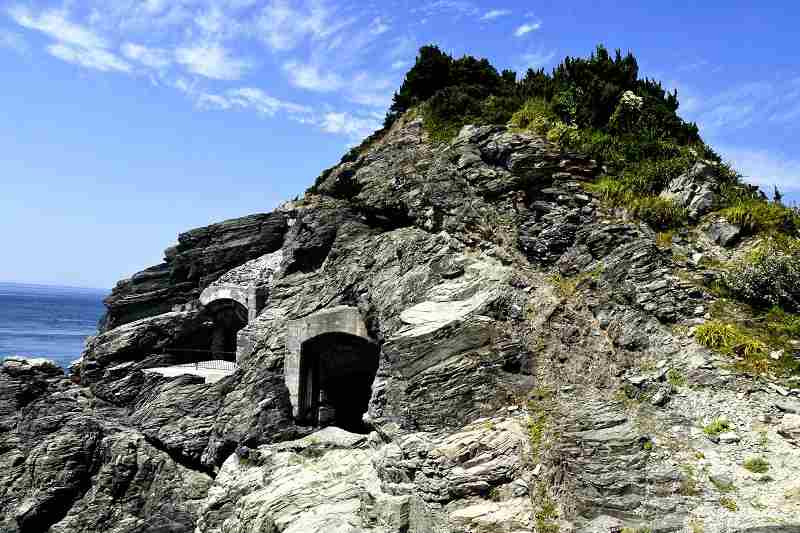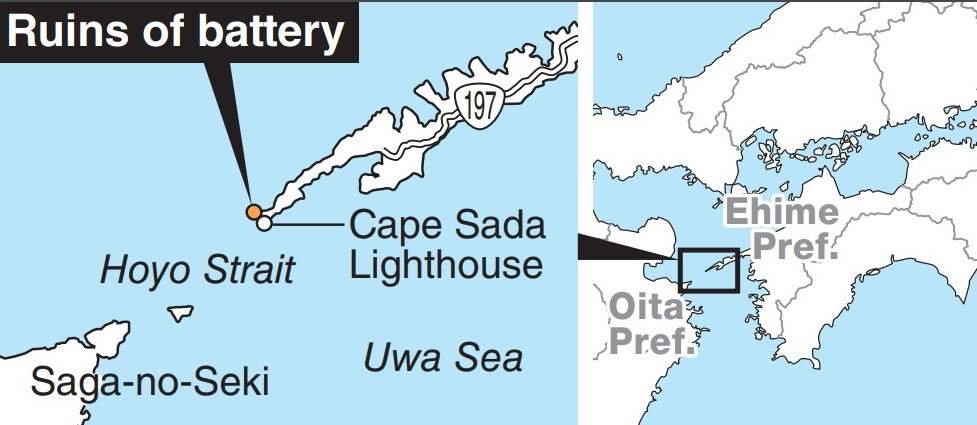
A battery carved into a cave is seen on Mikagojima island in Ikata, Ehime Prefecture.
16:30 JST, September 3, 2022
IKATA, Ehime — Jutting out of the west side of Shikoku in the direction of Kyushu, Cape Sada Peninsula is a spot where visitors can enjoy cycling and driving while gazing at the sea. The area is also dotted with remains that convey memories of the war.

Mikagojima island, where the remains of a cave-like gun battery are located, is at the tip of the peninsula in the town of Ikata, Ehime Prefecture.
A 30 minute walk along the promenade from a parking lot near the Cape Sada Lighthouse brings you to the island. It is connected to the tip of the cape by a seawall and has a circumference of about 400 meters.
The tunnel opens up on a rocky slope and was believed to have been dug by hand around March 1945, just as Japan’s defeat was becoming more and more apparent. The arched opening is about 5 meters high and the greenish rock surface inside is rugged.
From here, you can see all the way to Saga-no-seki in Oita Prefecture, 14 kilometers away beyond the Hoyo Strait. The remains of the battery were part of the Hoyo Fortress, built by the Imperial Army in the 1910s to protect the entrance to the Seto Inland Sea. The command center was located on the Kyushu side.
In 2016, while the municipality was constructing the park around the lighthouse, about 50 items were found under the earth and sand. These included rust-covered pedestals for old-style cannons that had a maximum range of about 5.5 kilometers.
“It may have been better than nothing for the people that were desperately trying to stop the U.S. forces,” said a local curator.
After the discovery, the town government categorized the cave as a war memorial, reinforced the cave and installed a replica of the cannon. A walking trail was also constructed. The cave has become a place for local students and others to learn about the reality of wartime and peace.

A replica of a cannon is seen inside the cave.
Three posts were also set up on the Cape Sada Peninsula to watch for incoming U.S. military aircraft. Local youths took turns standing at these outposts, and if they saw or heard U.S. aircraft approaching they would contact the police station, which would then issue an air raid warning.
“They must have been looking up at the sky with a single-minded desire to protect their home and family,” said Jin Tada, 55, a member of a local history research group.
Related Tags
"Features" POPULAR ARTICLE
-

Sanrio to Open Museum in Yamanashi Pref. Dedicated to Founder, Exhibits Include Hello Kitty, Other Characters
-

Autumn Foliage Surrounds Visitors to Tokyo’s Showa Kinen Park
-

My Daughter No Longer Speaks to Me, But I Want to See Her and My Grandchild
-

Kumamoto: Public Bath Refurbished as Library Where You Can Chat, Take Photos
-

Frozen Vegetables: Demand Rises for Convenient, Tasty Domestic Produce
JN ACCESS RANKING
-

Tokyo Economic Security Forum to Hold Inaugural Meeting Amid Tense Global Environment
-

Keidanren Chairman Yoshinobu Tsutsui Visits Kashiwazaki-Kariwa Nuclear Power Plant; Inspects New Emergency Safety System
-

Imports of Rare Earths from China Facing Delays, May Be Caused by Deterioration of Japan-China Relations
-

University of Tokyo Professor Discusses Japanese Economic Security in Interview Ahead of Forum
-

Japan Pulls out of Vietnam Nuclear Project, Complicating Hanoi’s Power Plans

























